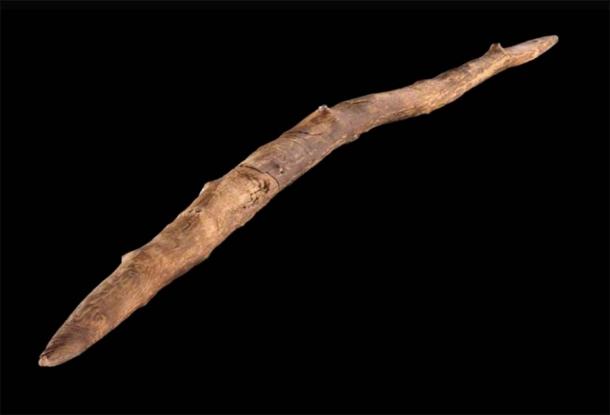

Excavated in the 1990s, the legendary Schöningen spears from Germany, the oldest weapons in human history, have consistently provided fascinating insights into the behavior of our early human ancestors. A newly published study claims that one of the Schöningen spears, a double-pointed wooden stick which was scraped, seasoned and sanded before use, shows that these early humans were woodworking masters.
Schöningen Spears and Hunting as a Community Activity
New research published in PLOS ONE magazine and based on analysis of the Schöningen spears has revealed that early humans possessed sophisticated woodworking skills that were underestimated until now. The development of lightweight weaponry may have played a crucial role in facilitating group hunts targeting medium and small-sized animals. This discovery suggests that the use of throwing sticks as hunting tools could have involved the active participation of the entire community, including children.
In fact, archaeological and ethnographic evidence of hunter-gatherer societies has shown that children were provided with smaller versions of adult weapons to be used as forms of pretense play, or learning tools. Sometimes, finely made scaled down weapons are provided to certain children to engage their participation in the hunting process.
Dr. Annemieke Milks of the University of Reading’s Department of Archaeology, who led the research into the Schöningen spears, explained:
“Discoveries of wooden tools have revolutionized our understanding of early human behaviors. Amazingly these early humans demonstrated an ability to plan well in advance, a strong knowledge of the properties of wood, and many sophisticated woodworking skills that we still use today. These lightweight throwing sticks may have been easier to launch than heavier spears, indicating the potential for the whole community to take part. Such tools could have been used by children while learning to throw and hunt.”

One of the Schöningen spears is a double pointed wooden throwing stick. (Volker Minkus / CC BY 4.0)
The Double-Pointed Stick: A Finely Crafted Weapon of Choice
Discovered in 1994, the 77cm-long (30.3 inches) stick is part of an assortment of various tools unearthed in Schöningen which came to be known as the Schöningen spears. Among these findings are throwing spears, thrusting spears and another similarly sized throwing stick. This double-pointed throwing stick likely served early humans as a hunting tool for capturing medium-sized game such as red and roe deer.
It may have also been employed to pursue fast-moving small prey like hare and birds, which were challenging to catch otherwise. Unlike the modern-day javelin, these throwing sticks were likely launched rotationally, similar to boomerangs, and could have been hurled as far as 30 meters (98.4 feet). Despite their lightweight nature, the high velocity at which these weapons could be launched would have resulted in powerful and lethal impacts.

An interactive 3D render of the double-pointed wooden throwing stick discovered in the stash of Schöningen spears provided by Sketchfab can be found here.
“The Schöningen humans used a spruce branch to make this aerodynamic and ergonomic tool,” explained co-author Dirk Leder. “The woodworking involved multiple steps including cutting and stripping off the bark, carving it into an aerodynamic shape, scraping away more of the surface, seasoning the wood to avoid cracking and warping, and sanding it for easier handling.”
The fine surface, meticulously shaped points and signs of polish from repeated handling indicate that this throwing stick was a personal tool used multiple times rather than a hastily crafted item meant for careless disposal. Tree ring analysis carried out during the course of study pointed towards the same.
“Signs of discoloration and polish on rounded knots in the central section of the tool indicate where it was likely held, and suggest a long use life. There is an absence of traces on either point that would indicate use as a digging stick, characterized by use-wear focused at the ends including randomly oriented striations, blunt and split tips, pitting, splinter negatives, and use polish… the double-pointed stick could have had a secondary function as a short stabbing tool,” wrote the authors of the study.

One of the Schöningen Spears in situ during excavations. (P. Pfarr NLD / CC BY-SA 3.0 DE)
The Legendary Schöningen Spears: A Brief Biography
The spears were found during archaeological excavations between 1994 and 1998 at Schöningen, a town in Lower Saxony, Germany. The site yielded a total of ten wooden spears, now known as the Schöningen Spears, each made from the trunk of a spruce tree and measuring between 1.82 and 2.33 meters (6 to 7.6 feet) in length. They were shaped and sharpened using stone tools, exhibiting exceptional craftsmanship for the time period, according to a Smithsonian report.
“The systematic analysis of the wooden finds of the Schöningen site financed by German Research Foundation provides valuable new insights and further exciting information on these early wooden weapons can be expected soon,” stressed principal investigator Thomas Terberger,
The discovery of the Schöningen Spears provided valuable insights into the hunting practices and technological capabilities of early human ancestors, according to a 2020 study published in Nature Ecology & Evolution. The presence of these spears at the site suggests that Homo heidelbergensis, an extinct human species, was capable of complex planning, group coordination and efficient hunting strategies. It also indicates that they had the ability to manufacture and use sophisticated tools.
“The two-throwing sticks from Schoningen present a fascinating addition to the Middle Pleistocene toolkit, with new potentials in terms of hunting strategies, prey selection, and communal involvement in hunting including by children and/or adolescents,” conclude the authors of the study.